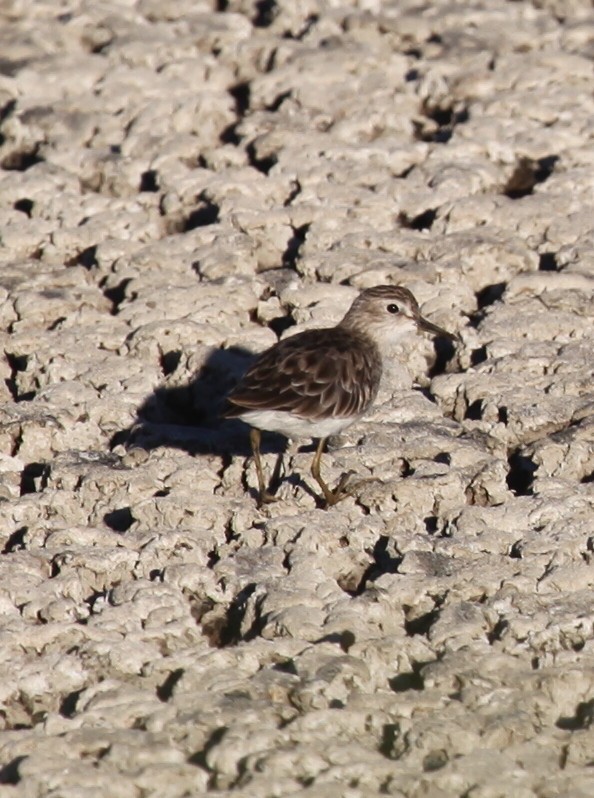Long-toed Stint
A species of Calidris Scientific name : Calidris subminuta Genus : Calidris
Long-toed Stint, A species of Calidris
Botanical name: Calidris subminuta
Genus: Calidris
Content
Description General Info
 Photo By http://www.comebirdwatching.blogspot.com/ , used under CC-BY-SA-3.0 /Cropped and compressed from original
Photo By http://www.comebirdwatching.blogspot.com/ , used under CC-BY-SA-3.0 /Cropped and compressed from original Description
The long-toed stint is a very small wader measuring just 13 to 16 cm (5.1 to 6.3 in) in length with a wingspan of 26.5 to 30.5 cm (10.4 to 12.0 in). It weighs about 25 g (0.9 oz). It has a small head and short, straight sharp-tipped beak. The neck is slender,the belly rounded and the long legs are set well back. The toes are long and slender, especially the middle one. The primary feathers extend as far as the tail. The crown is brown and there is a pale streak just above the eye. The upper parts are brown with the centres of the feathers darker brown. The breast is speckled with pale brown and the underparts are white. The legs and feet are yellow and the beak dark brown, apart from the base of the lower mandible which is yellow or pale brown. This bird has a distinctive stance and its flight call distinguishes it from other sandpipers. On the ground it can be confused with the red-necked stint (Calidris ruficollis) but is more finely built and slightly smaller. 
Size
13-15 cm (5-6 in)
Nest Placement
Ground
Feeding Habits
Long-toed Stint consumes a varied diet including insects, small gastropod molluscs, crustaceans, and seeds. It forages by probing and picking at mudflats, displaying unique adaptations for extracting prey from wet substrates.
Habitat
The long-toed Stint occupies various wetland environments, including freshwater and brackish habitats such as lakes, marshes, and human-made sites like sewage ponds. In its breeding range, it prefers subarctic open bogs or mountain tundra within the taiga zone, up to 1100 meters. Non-breeding habitats span inland wetlands, rice fields, and edges of coastal zones, with occasional use of muddy depressions as hiding spots.
Dite type
Aquatic invertebrate eater
General Info
Feeding Habits
Bird food type
Behavior
The long-toed stint forages in wet habitats, probing the ground with its beak. It feeds on molluscs, crustaceans, amphibians, insects, other invertebrates and seeds. It roosts in hollows in soft mud or in low vegetation bordering its feeding area. In its breeding range in Russia its habitat is tundra, taiga, open grassy bogs or swamps. The nesting site tends to be in an area with mosses, sedges and dwarf willows and is typically a well-hidden, shallow depression on a mound of sedge or dried grass. 
Distribution Area
The long-toed stint breeds in Siberia during the Northern Hemisphere summer. Little is known of its breeding habits but its breeding range includes the Chukchi Peninsula, the Koryak Plateau, the Commander Islands, the Kuril Islands, land bordering the Sea of Okhotsk, north Verkhoyansky District and around the Ob River and the Irtysh River. After the breeding season it migrates southwards passing through China, Indochina, Malaysia and the Philippines and westwards to Burma, Bangladesh, Nepal, Sri Lanka and the Maldive Islands. It is a visitor to New Guinea and Australia and a vagrant to Sweden, South Africa, Melanesia, Hawaii, the northwestern USA and the vicinity of the Bering Sea. In its over-wintering range it visits a variety of wetland habitats including shallow freshwater or brackish areas, lakes, swamps, floodplains, marshes, lagoons, muddy shores and sewage ponds. 
Species Status
Not globally threatened.

 Photo By http://www.comebirdwatching.blogspot.com/ , used under CC-BY-SA-3.0 /Cropped and compressed from original
Photo By http://www.comebirdwatching.blogspot.com/ , used under CC-BY-SA-3.0 /Cropped and compressed from original Scientific Classification
Phylum
Chordates Class
Birds Order
Shorebirds Family
Sandpipers Genus
Calidris Species
Long-toed Stint